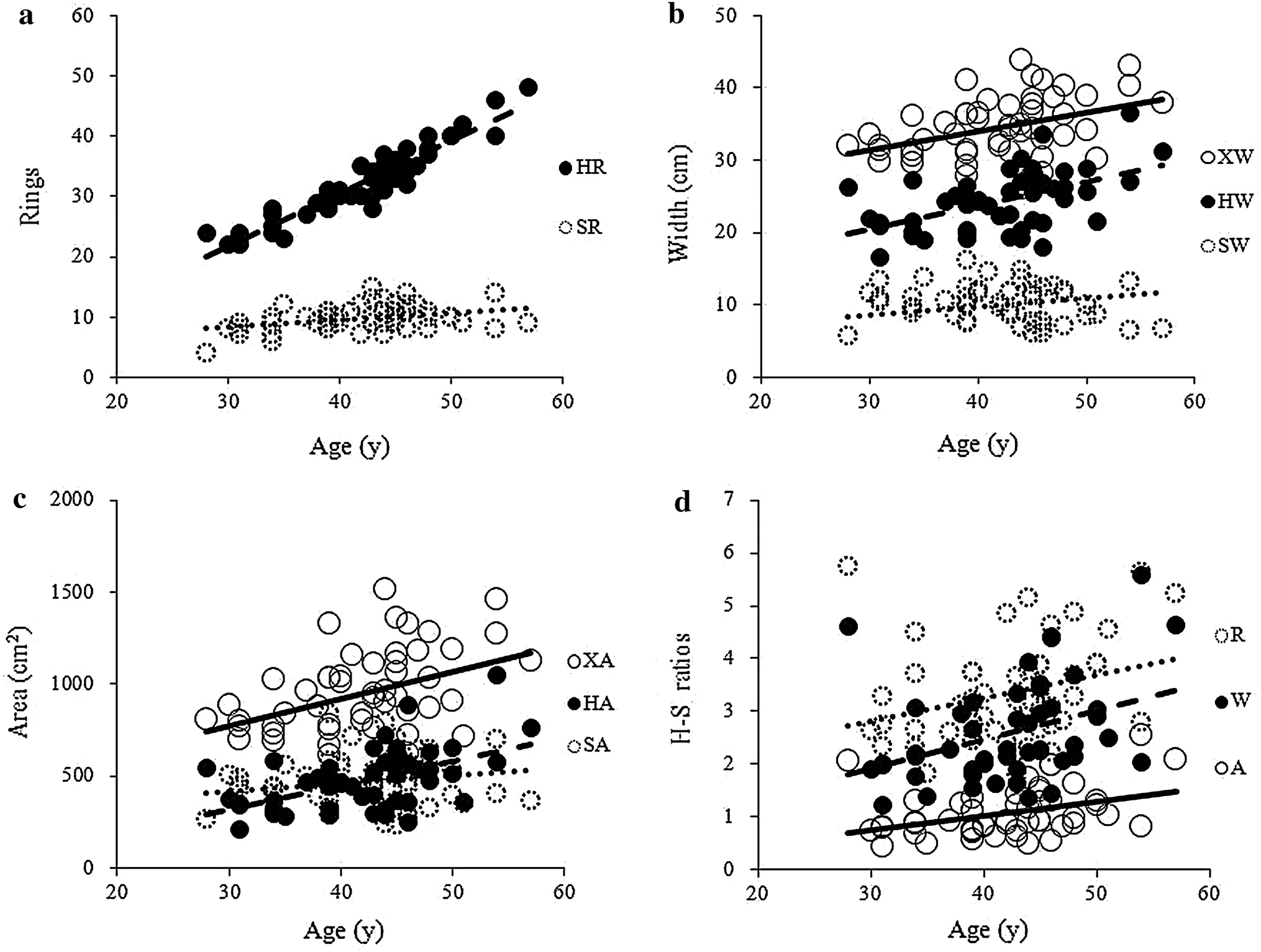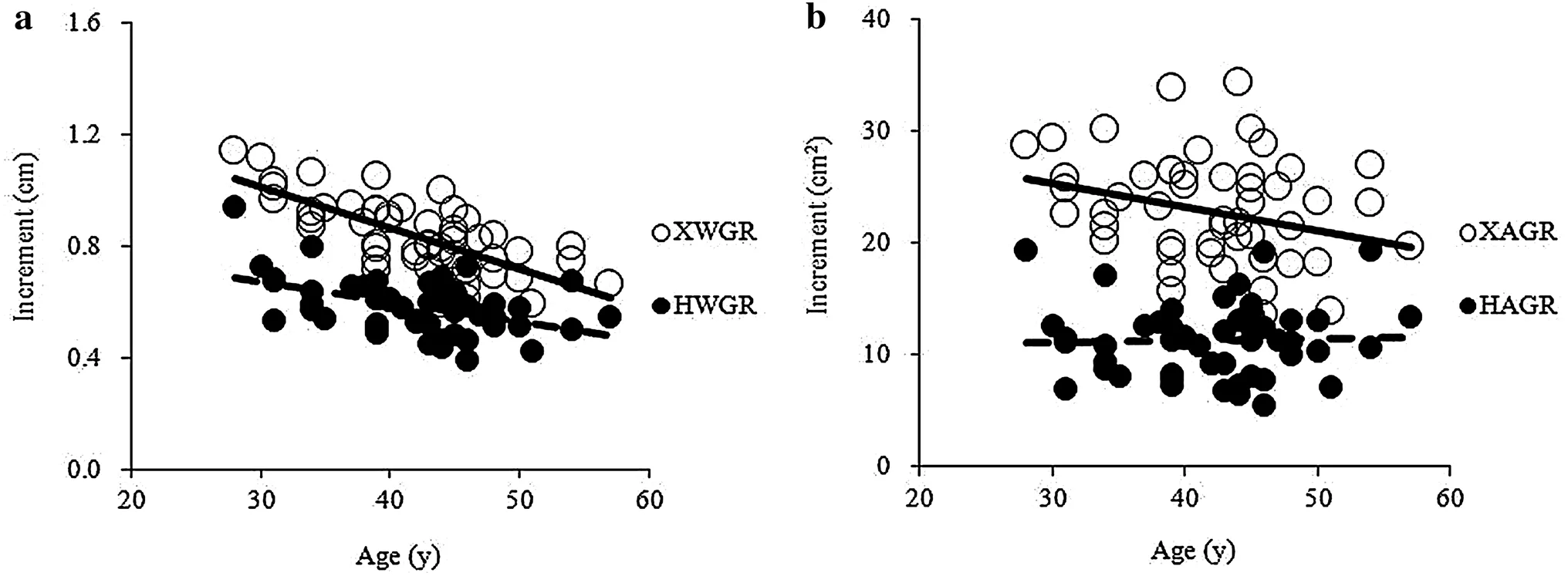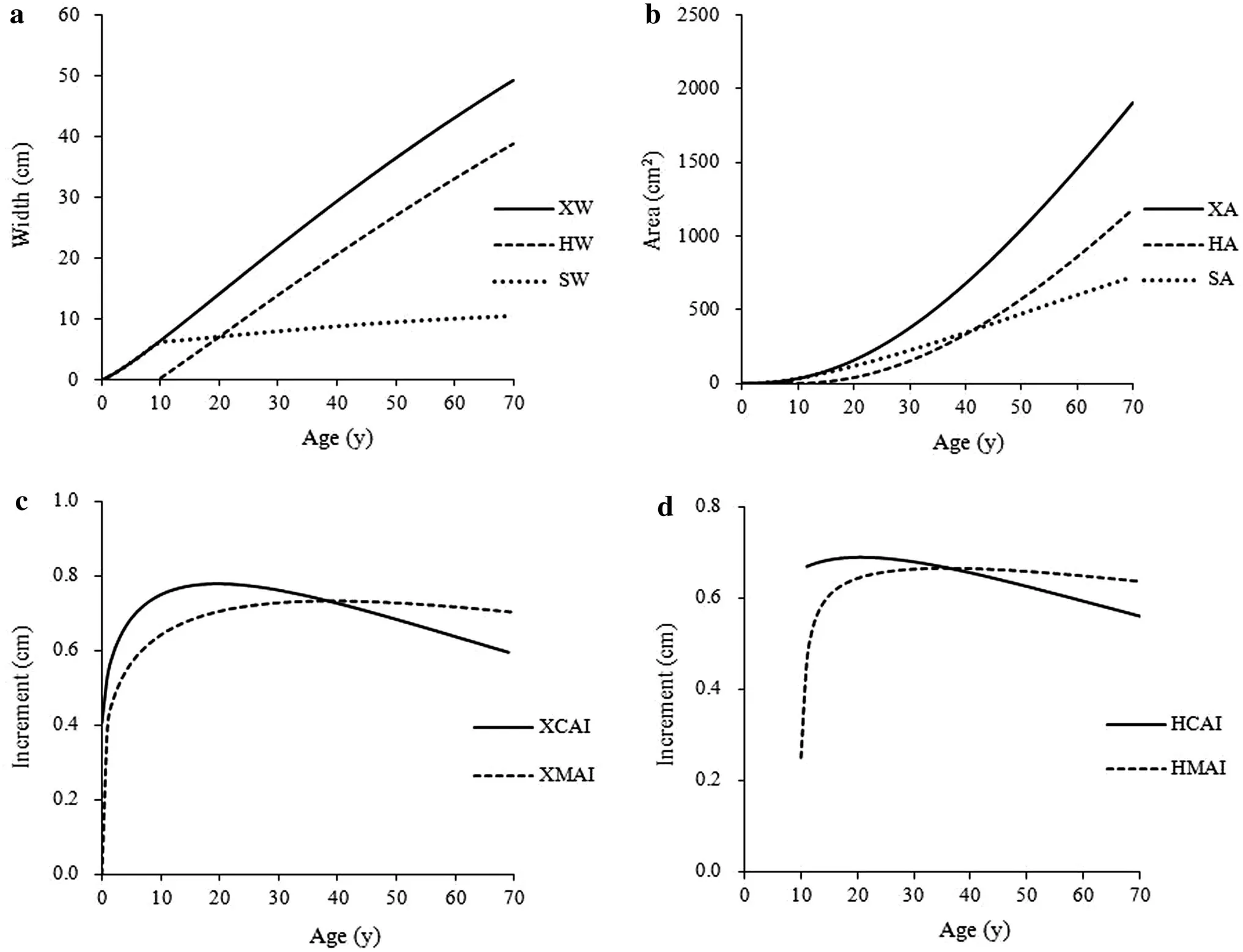Simulating the heartwood formation process of Erythrophleum fordii in South China
2015-06-09•••
•••
ORIGINAL PAPER
Simulating the heartwood formation process of Erythrophleum fordii in South China
Zhigang Zhao1•Junjie Guo1•Chunsheng Wang1•Jie Zeng1
©Northeast Forestry University and Springer-Verlag Berlin Heidelberg 2015
We studied the formation of heartwood inErythrophleum fordiiOliv.,an endangered rosewood species,by cross-section analysis on 52 stumps aged 28–57 years and arbitrarily sampled fromnaturalforestsin South China.Width and areaofheartwood werepositively correlated with age and xylem width(XW),and were independent of annual radial growth.The proportions of heartwood and sapwood areas were equal at about 40 years.The heartwood formation process was simulated by linear regression of age and XW.
Erythrophleum fordii⋅Growth process⋅Heartwood formation⋅Heartwood width⋅Rosewood species
Introduction
The xylem of most tree species at a given age is composed of two histologically similar but physiologically different zones,heartwood in the inner part and sapwood at the periphery(Niklas 1997;Taylor et al.2002;Wang et al. 2010).Heartwood differs from sapwood in anatomical and physiological features.Heartwood is generally darker in color and more dense and stiff than sapwood(Taylor et al. 2002;Spicer 2005).The relative proportions of heartwood and sapwood impact the utilization of wood(DeBell and Lachenbruch 2009).For solid wood applications,the different properties of heartwood and sapwood inf l uence drying,durability and aesthetic values of wood for manufacture of panel and furniture(DeBell and Lachenbruch 2009;Moya and Berrocal 2010).Especially for rosewood species,the heartwood is usually the main part of the xylem used in processing of wood products.
During recent decades,heartwood formation has been reported for a number of tree species in terms of its anatomy, physiology and silviculture.It is well-known that heartwood formation is in fact an active program of tissue senescence, and is mainly regulated by internal hormones that prompt secondary metabolic activities in parenchyma cells of aging sapwood before cell death(Spicer 2005).In silvicultural studies of heartwood formation,age and growth rates are usually considered the main factors inf l uencing variations in the ratio of heartwood to sapwood between or within species (Yang and Hazenberg 1991;Stokesand Berthier2000;Taylor et al.2002;Pe´rez et al.2004).Mono-variable equations are commonly used to modelheartwood formation processes and predict heartwood content by tree age.Examples include linear equations for 7 Chinese temperate tree species(Wang et al.2010),second polynomial regression curves forPinus pinaster(Knapic and Pereira 2005),and logarithmical equations forTectona grandisL.(Cordero and Kanninen 2003). However,it is still in doubt whether heartwood content depends on tree growth rate.Knapic and Pereira(2005) reported that tree growth rate had no signif i cant effect on heartwood properties in some studies,while Woeste(2002) and DeBelland Lachenbruch(2009)showed thatrapid growth resulted in increases ofboth heartwood and sapwood contentswith a greater proportion of heartwood.Recent studies on heartwood formation focused mainly on middle-and shortrotation tree species,while the heartwood formation dynamics and growth rates of valuable tropical tree species are poorly known(Worbes et al.2003).Except forT.grandisL. (Cordero and Kanninen 2003),little has been reported on heartwood formation by tropical valuable species.
Erythrophleum fordii(Caesalpiniaceae)is a rosewood species of Southeast Asia and south China,and is listed by IUCN as globally endangered(IUCN 2015).It is naturally distributed between latitude 16°N and 24°N(Nghia 2006; Zhao etal.2009).Itsheartwood hasbeen used in shipbuilding, construction,carving and furniture making for several hundred years.In south China,increasing attention has been focused on the development ofE.fordiiplantations to meet the increasing demandsforitstimberand to eff i ciently protect the species in natural forests.However,little is known about its heartwood formation process,andE.fordiiplantations have widely been managed using techniquesfor fast-growing and high-yield plantations.This could result in reduced value of timber harvested from the plantations(Pe´rez et al.2004; Moya and Berrocal 2010).Our objectives were to assess heartwood formation in relation to age and xylem width (XW),to analyze the dynamics of heartwood and sapwood proportions in xylem,and to model the process of heartwood formation byE.fordii.Our goal in this research was to contribute to development of technological guidelines for sustainable plantation management of this tree species.
Materials and methods
Site description
The study was carried out in natural forests ofE.fordiiat the southern fringe of Damingshan Mountain located at Liangjiang Town,Wuming County,Guangxi Zhuang Autonomous Region,China(23°27′–28′N,108°22′–23′E). This area supports the largest natural populations of this species in south China.E.fordiigrows at elevations of 200–600 m asl.on slope gradients of 15°–20°.E.fordiiis a dominant species in the forest at 400–500 m asl.
Field sampling and measurements
Although local government regulations prohibit logging ofE.fordii,trees have been illegally harvested with increasing frequency since 2007.Since few plantations of this species were old enough for study of heartwood formation, the tall stumps remaining after illegal felling provided a resource to assess the process of heartwood formation for this species(Rugmini and Jayaraman 2009).Stem discs were sampled on residual stumps in December 2010. Considering that rings in the discs were not clear due to decaying sapwood and dark-colored heartwood,discs were only sampled from fresh stumps.Since stem shape at the base near the collar was usually irregular,3-cm-thick discs were obtained at a height of 22–30 cm from ground level, and the serial number,height and north direction were marked on the upper cross-section of each disc.A total of 52 stumps were sampled on a slope of southwesterly aspect at elevations ranging from 400 to 500 m.Stump diameters ranged from 27.2 to 45.8 cm,averaging 35.7 cm(n=52). Sample stem discs were polished and sanded in the laboratory of the Research Institute of Tropical Forestry,Chinese Academy of Forestry(CAF).
To measure the relative proportions of heartwood and sapwood,the boundary separating them must be def i ned fi rst,and true and false growth rings must be discriminated. As shown in Fig.1,heartwood and sapwood ofE.fordiiwere distinguished visually based on their difference in color:heartwoods were dark brown and sapwoods were light yellow.False growth rings are a common source of error in tree ring research,especially for tropical evergreen species(Worbes 1999;Copenheaver et al.2006).False rings are commonly observed in stems ofE.fordii.However,false rings can generally be identif i ed by abrupt color changes between earlywood and latewood transition and width between adjacent bands.True rings are often uniform and complete along the entire annual ring while false rings are generally incomplete or not uniform(Cherubini et al. 2003;Copenheaver et al.2006).
Using the above criteria,we visually discriminated heartwood from sapwood and true from false growth rings and marked the heartwood-sapwood boundary and recordedthe number of growth rings on the sample discs.For each disc,the numbers of xylem rings(XR)and heartwood rings (HR)were counted,and the width of each annual ring was measured at 4 radial directions(north,south,east and west) to the nearest 0.01 mm using a Vernier caliper.
Data analysis
Width of xylem(XW),heartwood(HW)and sapwood (SW)were calculated using the following formula,

whereWX,WHWandWSWare width of xylem,heartwood and sapwood,andWE,WW,WN,WSare width of xylem, heartwood and sapwood at 4 radial directions(E,east;W, west;N,north;S,south),respectively.
The cross-sectional area of xylem(XA)and heartwood (HA)was calculated by width,assuming that the crosssection and heartwood region were circular.The width and area of sapwood were calculated by those of xylem(XW,XA)and heartwood(HW,HA),respectively.

whereAandWare area and width of xylem or heartwood, and subscripts X,HW and SW are xylem,heartwood and sapwood,respectively.
Annual growth rates of xylem and heartwood widths (XWGR and HWGR)were calculated with width of xylem (XW)and heartwood(HW)divided by ring numbers(RN)of xylem(XR)and heartwood(HR)correspondingly,and annual growth rates of their areas were calculated in the same way.

whereGRWandGRAstand for growth rate of width and area,andW,AandRNfor width,area and age,respectively.Pearson’s correlation coeff i cient was calculated to quantify relationships between parameters for xylem,sapwood and heartwood.
Correlation between XW and age was simulated by Richard’s growth equation,which has been used extensively to quantify growth processes of tree species.The formula was

wherea,b,care constants.
Dynamics of heartwood width(HW)was affected by age and XW.The relationship between these was plotted using the following formula in comparison with monovariable equations such as linear equation,second polynomial regression curve and logarithmical equation mentioned above.

wherea,b,care constants.Heartwood area(HA)was then calculated on the basis of expected HW.
To examine the performance of the above four models, error statistics(mean error,mean absolute error and mean squared error)of each model were calculated(Hein and Spiecker 2007).

Tree growth and heartwood formation process were analyzed by current annual increment(CAI)and mean annual increment(MAI)of radial growth based on growth simulations of xylem(XW)and heartwood(HW)widths,

where i is the age.
Data analysis was conducted with SPSS ver.11.5 software.
Results and discussion
Rings,width and area variation of xylem and heartwood
The number of xylem rings(XR)of 52 sampledE.fordiistumps ranged from 27 to 56.Since seedlings of this species need approximately 1 year to reach the height of stumps(22–30 cm)in natural forests,the age of each tree was estimated as one plus its ring number at stump height. The age of sampled trees ranged from 28 to 57 years.
With increasing age,the number of rings and width and area of heartwood(HR,HW and HA)increased(Fig.2). These parameters for sapwood(SR,SW and SA)increased or decreased slightly and remained approximately constant in accordance with the studies ofT.grandisL.(Cordero and Kanninen 2003),Eucalyptus globulusLabill.(Miranda et al.2006;Morais and Pereira 2007;Miranda et al.2009),Picea abies(L.)Karst(Sellin 1994),andPinus pinasterAit.(Knapic and Pereira 2005).This implies that older and larger trees normally contained greater proportions of heartwood(Knapic and Pereira 2005;Morais and Pereira 2007;DeBell and Lachenbruch 2009)and the ratios of HRto SR,HW to SW,and HA to SA thus also increased with tree age and size.The plotted trend lines of HA and SA crossed near 40 years of age(Fig.2),showing that the proportion of HA in xylem was larger than that of SA after 40 years of growth.The growth rates of xylem and heartwood width(XWGR and HWGR)decreased with tree age,while the growth rate of heartwood area(HAGR) increased slightly and the growth rate of xylem area (XAGR)decreased with increasing age(Fig.3).

Fig.2 Dynamics of numbers of growth rings,width,area of sapwood(SR,SW,SA),heartwood(HR,HW,HA)and xylem(XR,XW,XA),and ratios of heartwood and sapwood(H–S ratios)for Erythrophleum fordii

Fig.3 Mean annual width and area growth rate of xylem(XWGR,XAGR)and heartwood(HWGR,HAGR)of Erythrophleum fordii
There was great variation in heartwood width and area among sampled trees even when tree ages were similar (Fig.2).Heartwood formation can be affected by tree genotype and environmental factors(Woeste 2002). Because the environmental conditions for all trees sampled on our study site were generally similar,heartwood formation was probably regulated genetically rather than environmentally.This suggests that breeding programs could be implemented to produce trees that would yield more heartwood(Taylor et al.2002;Langat and Kariuki 2004).
Xylem,heartwood and sapwood allometry
Ring number(HR),width(HW)and area(HA)of heartwood were strongly positively correlated with ring number (XR),width(XW)and area(XA)of xylem,respectively. Signif i cant correlations between sapwood parameters were recorded between SR and XR,SW and XW,SA and XA (Table 1).HR and SR,HW and SW,and HA and SA were not correlated(Table 1),indicating that the growth attributes of heartwood were independent of those of sapwood. Heartwood width and area(HW and HA)were strongly and positively correlated with width and area of xylem (XW and XA).Neither HW nor HA was correlated with the growth rate of xylem width(XWGR,annual radial growth,Table 1).Growth rate of heartwood(HWGR)was correlated with XW.Heartwood width(HW)and area (HA)were correlated with XW.Growth rate of heartwood area(HAGR)was signif i cantly positively correlated with HW,HA,XW and XA.This is in agreement with Knapic and Pereira’s(2005)study ofPinus pinaster,but contrasts with Woeste’s(2002)conclusion from a 35-year progeny test ofJuglans nigraL.that faster growing trees had more heartwood.
Growth process simulation of xylem and heartwood
According to Richard’s equation,the growth process of XW forE.fordiicould be modeled with the following exponential formula:


?

Fig.4 Growth of width and area of xylem(XW and XA),heartwood(HW and HA)and sapwood(SW and SA)based on simulated curve models for Erythrophleum fordii.X(H)CAI and X(H)MAI are current and mean annual increment of simulated XW and HW

Table 2 Equations describing the heartwood formation process of Erythrophleum fordii
The curves describing its current annual increment (XCAI)and mean average increment(XMAI)crossed at about 40 years of tree age(Fig.4c).
Equations describing the heartwood growth process ofE.fordiiwere shown in Table 2.Based onR2,signif i cance and error statistics,the deviation between measured and predicted values for HW when using the bivariate equation was considerably lower than when using the three monovariable equations(Table 2).The bivariate regression more accurately predicted HW than did the three mono-variable equations and this is supported by the fact that HW had strong positive correlations with age and XW.
The curve of HW and SW crossed at about 20 years of tree age(Fig.4a).The intersect was at 40 years of agewhen HA equaled to SA(Fig.4b)and heartwood would occupy more than 50%of stem cross-section from 40 years onward,supporting the result shown in Fig.2. Additionally,as deduced from Formula(12)and(13),the curves for xylem CAI and MAI(Fig.4c)and for heartwood CAI and MAI(Fig.4d)also intersected at that time. Therefore,40 years is a key age for growth processes ofE. fordiiand we infer that plantations should be harvested when more than 40 years old,and the species should be managed as a long-rotation hardwood.
Conclusion
The heartwood width and area ofE.fordiiwere positively correlated with age and XW,and were independent of annual radial growth in the present study.The proportions of heartwood and sapwood areas were equal at about 40 years of tree age.The heartwood formation process was modelled most accurately by linear regression of XW and age.However,because our work was a preliminary study of heartwood formation based on stumps ofE.fordii,we recommend that trunks of plantation-grown trees should be sampled in future for more precise and full-scale assessment of heartwood formation.
AcknowledgmentsWe are grateful to Mr.Er Sha and Ms.Kai-Qin Lin for their assistance in f i eld sampling and disc measurement.We also thank Dr.Khongsak Pinyopusarerk of Black Mountain Laboratories of CSIRO Plant Industry,Australia for his editing of drafts of this manuscript.
Cherubini P,Gartner BL,Tognetti R,Bra¨ker OU,Schoch W,Inner JL (2003)Identif i cation,measurement and interpretation of tree rings in woody species from mediterranean climates.Biol Rev 78:119–148
Copenheaver CA,Pokorski EA,Currie JE,Abrams MD(2006) Causation of false ring formation inPinus banksiana:a comparison of age,canopy class,climate and growth rate.For Ecol Manag 236:348–355
Cordero LDP,Kanninen M(2003)Heartwood,sapwood and bark content,and wood dry density of young and mature teak (Tectona grandis)trees grown in Costa Rica.Silva Fenn 37:45–54
DeBell JD,Lachenbruch B(2009)Heartwood/sapwood variation of western red cedar as inf l uenced by cultural treatments and position in tree.For Ecol Manag 258:2026–2032
Hein S,Spiecker H(2007)Comparative analysis of occluded branch characteristics forFraxinus excelsiorandAcer pseudoplatanuswith natural and artif i cial pruning.Can J For Res 37:1414–1426
IUCN(2015)The IUCN Red list of threatened species.version 2015.1.www.iucnredlist.org.Downloaded on 11 June 2015
Knapic S,Pereira H(2005)Within-tree variation of heartwood and ring width in maritime pine(Pinus pinasterAit.).For Ecol Manag 210:81–89
Langat DK,Kariuki JG(2004)Variations in heartwood proportion and basic density between provenances ofEucalyptus grandisin Kenya.J Trop For Sci 16:179–186
Miranda I,Gominho J,Lourenco A,Pereira H(2006)The inf l uence of irrigation and fertilization on heartwood and sapwood contants in 18-year-oldEucalyptus globulustrees.Can J For Res 36:2675–2683
Miranda I,Gominho J,Lourenco A,Pereira H(2009)Variation of heartwood and sapwood in 18-year-oldEucalyptus globulustrees grown with different spacings.Trees 23:367–372
Morais MC,Pereira H(2007)Heartwood and sapwood variation inEucalyptus globulusLabill.trees at the end of rotation for pulpwood production.Ann For Sci 64:665–671
Moya R,Berrocal A(2010)Wood colour variation in sapwood and heartwood of young trees ofTectona grandisand its relationship with plantation characteristics,site,and decay resistance.Ann For Sci 67:109
Nghia HN(2006)Forest genetic resources conservation and management in vietnam-an update on activities,challenges and needs since APFORGEN inception in,2003.In:Hong LT,Sim HC(eds)Forest genetic resources conservation and management.Dehradun,IPGRI-APO,pp 101–106
Niklas KJ(1997)Mechanical properties of Black Locust(Robinia pseudoacaciaL.)wood.Size-and age-dependent variations in sap-and heartwood.Ann Bot 79:265–272
Pe´rez D,Kanninen M,Matamoros F,Fonseca W,Chaves E(2004) Heartwood,sapwood and bark contents ofBombacopsis quinatain Costa Rica.J Trop For Sci 16:318–327
Rugmini P,Jayaraman K(2009)Intrinsic units of growth for teak. Trees 23:51–58
Sellin A(1994)Sapwood and heartwood proportion related to tree diameter,age,and growth rate inPicea abies.Can J For Res 24:1022–1028
Spicer R(2005)Senescence in secondary xylem:heartwood formation as an active develop-mental program.In:Holbrook NM, Zwieniecki MJ(eds)Vascular transport in plants.Elsevier Academic Press,Amsterdam,pp 457–475
Stokes A,Berthier S(2000)Irregular heartwood formation inPinus pinasterAit.is related to eccentric,radial,stem growth.For Ecol Manage 135:115–121
Taylor AM,Gartner BL,Morrell JJ(2002)Heartwood formation and natural durability-a review.Wood Fiber Sci 34:587–611
Wang XC,Wang CK,Zhang QZ,Quan XK(2010)Heartwood and sapwood allometry of seven Chinese temperate tree species.Ann For Sci 67:410
Woeste KE(2002)Heartwood production in a 35-year-old black walnut progeny test.Can J For Res 32:177–181
Worbes M(1999)Annual growth rings,rainfall-dependent growth and long-term growth patterns of tropical trees from the Caparo Forest Reserve in Venezuela.J Ecol 87:391–403
Worbes M,Staschel R,Roloff A,Junk WJ(2003)Tree ring analysis reveals age structure,dynamics and wood production of a natural forest stand in Cameroon.For Ecol Manag 173:105–123
Yang KC,Hazenberg G(1991)Sapwood and heartwood width relationship to tree age inPinus banksiana.Can J For Res 21:521–525
Zhao ZG,Guo JJ,Sha E,Lin KQ,Zeng J,Xu JM(2009)Geographic distribution and phenotypic variation of fruit and seed ofErythrophleum fordiiin China.Chin Bull Bot 44:338–344
26 February 2014/Accepted:30 May 2014/Published online:21 July 2015
Project fund:This work was f i nancially supported by the Special Research Program for Public-welfare Forestry(No.201204301-2) and National Nonprof i t Institute Research Grant of RITF
(No.RITFKYYW2010-05).
The online version is available at http://www.springerlink.com
Corresponding editor:Yu Lei
✉Jie Zeng
zengdasan@hotmail.com
1Research Institute of Tropical Forestry,CAF,Longdong, Guangzhou 510520,China
杂志排行
Journal of Forestry Research的其它文章
- Drone remote sensing for forestry research and practices
- Life cycle environmental impact assessment of biochar-based bioenergy production and utilization in Northwestern Ontario, Canada
- Growth rates of Eucalyptus and other Australian native tree species derived from seven decades of growth monitoring
- Effect of f i rst thinning and pruning on the individual growth of Pinus patula tree species
- The inf l uence of selective cutting of mixed Korean pine(Pinus koraiensis Sieb.et Zucc.)and broad-leaf forest on rare species distribution patterns and spatial correlation in Northeast China
- Modeling forest f i res in Mazandaran Province,Iran
